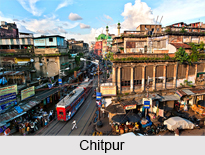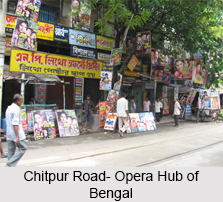 Chitpur is an urban area located in Kolkata, West Bengal. The entire area of Chitpur is concentrated with the opera companies which are popular in West Bengal. Not only are those, these operas are popular in the other states like Jharkhand, Odisha and Chattisgarh.
Chitpur is an urban area located in Kolkata, West Bengal. The entire area of Chitpur is concentrated with the opera companies which are popular in West Bengal. Not only are those, these operas are popular in the other states like Jharkhand, Odisha and Chattisgarh.
History of Chitpur
Chitpur has its existence before the establishment of Kolkata with the hands of British East India Company. Chitpur has existed for at least 400 years. Chitpur received its name from the goddess Chiteswari, who had a splendid temple erected by Gobindram Mitter where human sacrifices used to be offered. The lofty dome of the temple, which was known as Nabaratna Temple or the shrine of nine jewels, fell during the earthquake of 1737, and it is now in ruins.
Mapping of Chitpur
Chitrapur is referred to in Bipradas Pipilai`s poem Manasamangal in 1495, but it could be a later interpolation. According to it, Chitpur was home to Chakrapani, Commander-in-Chief of the Nawab of Bengal`s army, and had a flourishing colony of artists. It refers to one Gobinda Ghosh as founder of the Chiteswari temple in 1610. The most notorious dacoit of the region was Chitey Dakat, who offered human sacrifices at the temple. The area of Chitpur could also have acquired its name from him.
Geography of Old Chitpur
 The old Chitpur has one of the thirty-eight villages whose right to rent the English obtained from Emperor Farukshiyar in 1717. It was later reorganised as Dihi Chitpur with Chitpur, Tala, Birpara and Kalidaha villages under it. There was a house and garden of Mahmed Reza Khan, the Chitpur Nawab, to whom the administration of Bengal was assigned for several years after the British East India Company acquired the Dewani of Bengal from the Mughal emperors in Delhi. The Chitpur Nawab lived on terms of intimacy with the `powers` of the day and was accounted by them as a personage of first rank. The foreign governors of Danish East India Company, French East India Company, and British East India Company on their visits to Kolkata from Sherampore, Chandannagar and Chinsurah, made it a practice to halt at Chitpur on their way to the Government House.
The old Chitpur has one of the thirty-eight villages whose right to rent the English obtained from Emperor Farukshiyar in 1717. It was later reorganised as Dihi Chitpur with Chitpur, Tala, Birpara and Kalidaha villages under it. There was a house and garden of Mahmed Reza Khan, the Chitpur Nawab, to whom the administration of Bengal was assigned for several years after the British East India Company acquired the Dewani of Bengal from the Mughal emperors in Delhi. The Chitpur Nawab lived on terms of intimacy with the `powers` of the day and was accounted by them as a personage of first rank. The foreign governors of Danish East India Company, French East India Company, and British East India Company on their visits to Kolkata from Sherampore, Chandannagar and Chinsurah, made it a practice to halt at Chitpur on their way to the Government House.
Circular Canal in Chitpur
The Circular Canal joins the Hooghly River at Chitpur. Early in the 20th century a large lock and tidal basin had been constructed, at the mouth of the canal. The Entally, Manicktala, Beliaghata, Ultadanga, Chitpur, Cossipore, parts of Beniapukur, Ballygunge, Watganj and Ekbalpur, and parts of Garden Reach and Tollygunj were added to Kolkata Municipal Corporation in 1888.
Modern Chitpur Road
Modern Chitpur is commencing in the extreme south, assumes the various names of Russa Road, Chowringhee Road, Bentick Street, Chitpore Road, and Barrackpur Trunk Road, forms a continuation of the Dum Dum Road and was the old line of communication between Murshidabad and Kalighat. It is said to occupy the site of the old road made by the Sabarna Roy Choudhurys, the old zemindars of Calcutta, from Barisha, where the junior branch resided, to Halisahar, beyond Barrackpore, which was the seat of the senior branch.
Aristocracy of Bengal
Chitpur Road was Kolkata`s oldest road. It was also known as the aristocratic road of early Bengal.



















